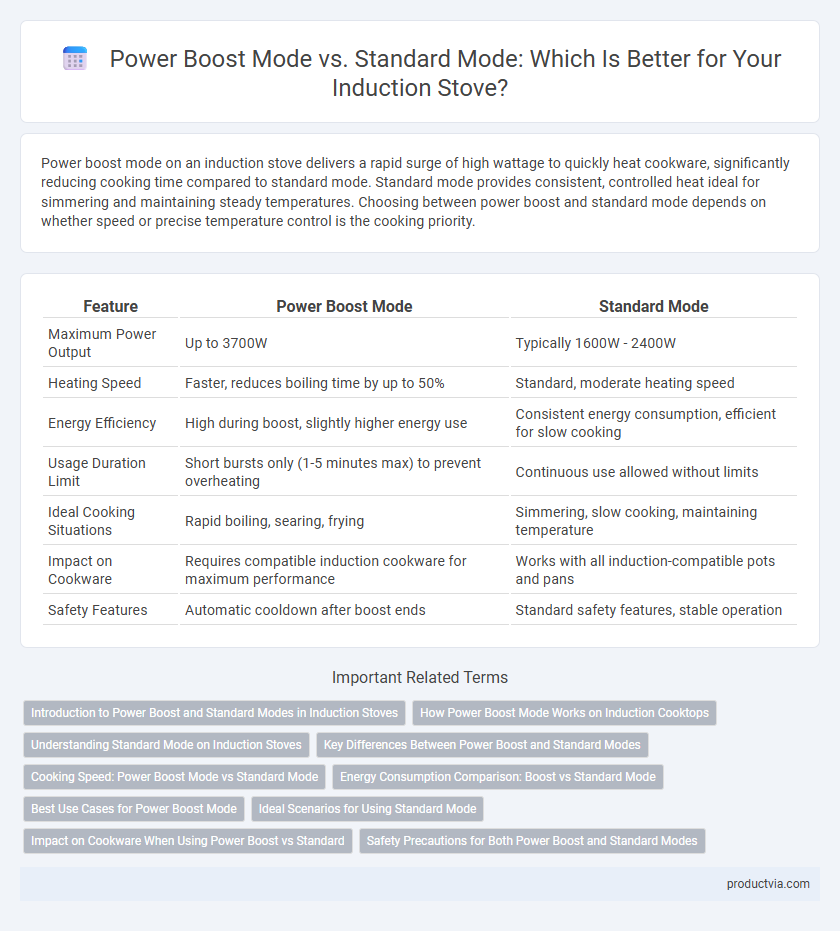Power boost mode on an induction stove delivers a rapid surge of high wattage to quickly heat cookware, significantly reducing cooking time compared to standard mode. Standard mode provides consistent, controlled heat ideal for simmering and maintaining steady temperatures. Choosing between power boost and standard mode depends on whether speed or precise temperature control is the cooking priority.
Table of Comparison
| Feature | Power Boost Mode | Standard Mode |
|---|---|---|
| Maximum Power Output | Up to 3700W | Typically 1600W - 2400W |
| Heating Speed | Faster, reduces boiling time by up to 50% | Standard, moderate heating speed |
| Energy Efficiency | High during boost, slightly higher energy use | Consistent energy consumption, efficient for slow cooking |
| Usage Duration Limit | Short bursts only (1-5 minutes max) to prevent overheating | Continuous use allowed without limits |
| Ideal Cooking Situations | Rapid boiling, searing, frying | Simmering, slow cooking, maintaining temperature |
| Impact on Cookware | Requires compatible induction cookware for maximum performance | Works with all induction-compatible pots and pans |
| Safety Features | Automatic cooldown after boost ends | Standard safety features, stable operation |
Introduction to Power Boost and Standard Modes in Induction Stoves
Power Boost mode in induction stoves delivers a rapid surge of maximum wattage, significantly reducing cooking time compared to Standard Mode, which provides consistent, moderate heat levels for everyday cooking. This feature is ideal for quickly boiling water or searing food, while Standard Mode ensures energy-efficient temperature control for simmering and gentle cooking. Users benefit from enhanced cooking flexibility by switching between Power Boost and Standard Modes based on meal preparation needs.
How Power Boost Mode Works on Induction Cooktops
Power Boost Mode on induction cooktops temporarily increases the magnetic field's frequency and strength, delivering a higher wattage output to the cookware for rapid heating. This mode overrides standard power limits by channeling extra electricity to the induction coil, enabling faster boiling and searing compared to standard mode. The technology enhances cooking efficiency by maximizing energy transfer directly to ferrous cookware via electromagnetic induction.
Understanding Standard Mode on Induction Stoves
Standard mode on induction stoves operates at consistent power levels, ensuring precise temperature control and energy efficiency by directly heating the cookware through electromagnetic fields. This mode allows steady cooking without sudden power surges, making it ideal for simmering, slow cooking, and maintaining stable heat. Its consistent energy output reduces the risk of overheating and preserves the quality of delicate dishes.
Key Differences Between Power Boost and Standard Modes
Power Boost mode on an induction stove delivers a surge of maximum wattage, significantly reducing heating time compared to Standard mode's consistent, lower power output. Standard mode maintains steady energy levels for precise temperature control, while Power Boost temporarily enhances power for rapid boiling or searing. Understanding this distinction helps users optimize cooking efficiency and energy consumption on induction cooktops.
Cooking Speed: Power Boost Mode vs Standard Mode
Power Boost mode on an induction stove delivers a higher wattage output, significantly accelerating cooking speed by rapidly increasing heat levels compared to Standard mode. Standard mode provides steady, consistent power ideal for simmering and maintaining temperature but heats food more slowly. Using Power Boost mode can reduce cooking times by up to 50%, making it efficient for boiling water or quick searing.
Energy Consumption Comparison: Boost vs Standard Mode
Power boost mode on induction stoves delivers higher wattage by increasing current flow, resulting in faster heating times compared to standard mode. Though boost mode consumes more energy per minute due to the intensified power output, the reduced cooking duration often leads to comparable or slightly lower overall energy consumption. Standard mode maintains consistent energy use at lower wattage levels, extending cooking time but potentially increasing total energy consumption for dishes requiring longer heating.
Best Use Cases for Power Boost Mode
Power Boost mode on induction stoves delivers a rapid surge in wattage, ideal for boiling large volumes of water quickly or searing meat at high temperatures to lock in flavors. Standard mode maintains consistent, moderate heat levels suitable for simmering sauces, melting chocolate, or slow cooking delicate dishes to prevent burning. Utilizing Power Boost mode optimizes cooking efficiency during high-heat tasks, while standard mode ensures precise temperature control for everyday culinary needs.
Ideal Scenarios for Using Standard Mode
Standard mode on induction stoves is ideal for slow cooking tasks such as simmering sauces, melting chocolate, or gently heating soups, where precise and consistent temperature control is essential. This mode maintains steady heat without fluctuations, preserving delicate flavors and preventing burning or boiling over. Home cooks benefit from standard mode during long cooking processes requiring careful attention to heat levels, ensuring optimal results.
Impact on Cookware When Using Power Boost vs Standard
Power boost mode on an induction stove delivers a higher wattage output than standard mode, rapidly increasing the cooking surface temperature but potentially causing uneven heat distribution that can stress cookware materials. Standard mode provides consistent and controlled heat, reducing the risk of warping or damaging sensitive pans by maintaining gradual temperature changes. Users should consider cookware manufacturer guidelines, as frequent use of power boost may shorten the lifespan of non-heat-resistant or thin-bottomed pots and pans.
Safety Precautions for Both Power Boost and Standard Modes
Power boost mode on induction stoves delivers higher wattage for rapid heating, requiring users to ensure cookware is compatible and avoid overheating to prevent accidents. Standard mode operates at lower power levels, reducing risks but still necessitates proper pan placement and avoiding prolonged use to maintain safety. Both modes demand attention to stove ventilation, regular surface cleaning, and using induction-certified utensils to optimize performance and prevent hazards.
Power boost mode vs standard mode for induction stove Infographic

 productvia.com
productvia.com